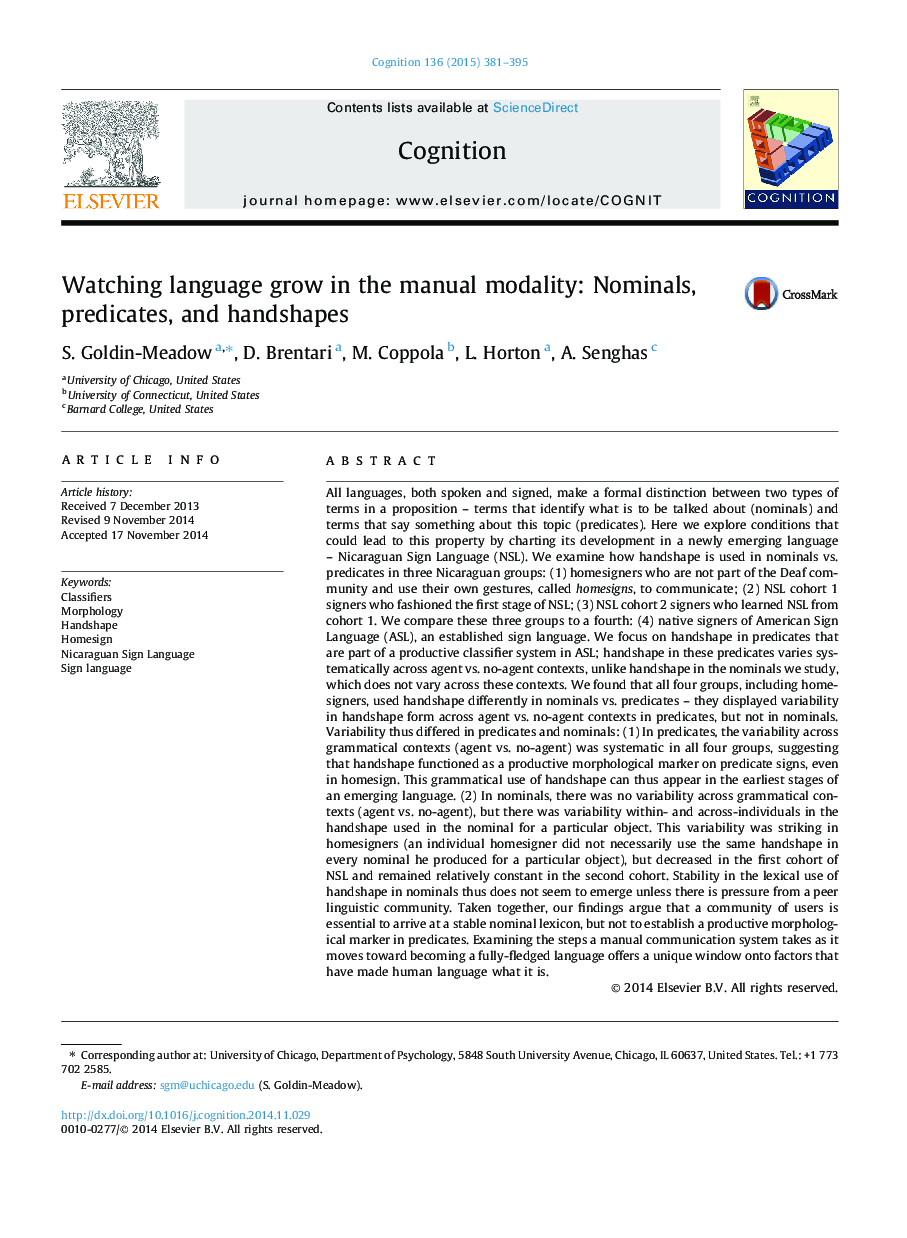| کد مقاله | کد نشریه | سال انتشار | مقاله انگلیسی | نسخه تمام متن |
|---|---|---|---|---|
| 7287417 | 1474131 | 2015 | 15 صفحه PDF | دانلود رایگان |
عنوان انگلیسی مقاله ISI
Watching language grow in the manual modality: Nominals, predicates, and handshapes
ترجمه فارسی عنوان
نگاه کردن به زبان در روش دستی افزایش می یابد: اسامی مستعار، اسم ها و دستها
دانلود مقاله + سفارش ترجمه
دانلود مقاله ISI انگلیسی
رایگان برای ایرانیان
کلمات کلیدی
موضوعات مرتبط
علوم زیستی و بیوفناوری
علم عصب شناسی
علوم اعصاب شناختی
چکیده انگلیسی
All languages, both spoken and signed, make a formal distinction between two types of terms in a proposition - terms that identify what is to be talked about (nominals) and terms that say something about this topic (predicates). Here we explore conditions that could lead to this property by charting its development in a newly emerging language - Nicaraguan Sign Language (NSL). We examine how handshape is used in nominals vs. predicates in three Nicaraguan groups: (1) homesigners who are not part of the Deaf community and use their own gestures, called homesigns, to communicate; (2) NSL cohort 1 signers who fashioned the first stage of NSL; (3) NSL cohort 2 signers who learned NSL from cohort 1. We compare these three groups to a fourth: (4) native signers of American Sign Language (ASL), an established sign language. We focus on handshape in predicates that are part of a productive classifier system in ASL; handshape in these predicates varies systematically across agent vs. no-agent contexts, unlike handshape in the nominals we study, which does not vary across these contexts. We found that all four groups, including homesigners, used handshape differently in nominals vs. predicates - they displayed variability in handshape form across agent vs. no-agent contexts in predicates, but not in nominals. Variability thus differed in predicates and nominals: (1) In predicates, the variability across grammatical contexts (agent vs. no-agent) was systematic in all four groups, suggesting that handshape functioned as a productive morphological marker on predicate signs, even in homesign. This grammatical use of handshape can thus appear in the earliest stages of an emerging language. (2) In nominals, there was no variability across grammatical contexts (agent vs. no-agent), but there was variability within- and across-individuals in the handshape used in the nominal for a particular object. This variability was striking in homesigners (an individual homesigner did not necessarily use the same handshape in every nominal he produced for a particular object), but decreased in the first cohort of NSL and remained relatively constant in the second cohort. Stability in the lexical use of handshape in nominals thus does not seem to emerge unless there is pressure from a peer linguistic community. Taken together, our findings argue that a community of users is essential to arrive at a stable nominal lexicon, but not to establish a productive morphological marker in predicates. Examining the steps a manual communication system takes as it moves toward becoming a fully-fledged language offers a unique window onto factors that have made human language what it is.
ناشر
Database: Elsevier - ScienceDirect (ساینس دایرکت)
Journal: Cognition - Volume 136, March 2015, Pages 381-395
Journal: Cognition - Volume 136, March 2015, Pages 381-395
نویسندگان
S. Goldin-Meadow, D. Brentari, M. Coppola, L. Horton, A. Senghas,
